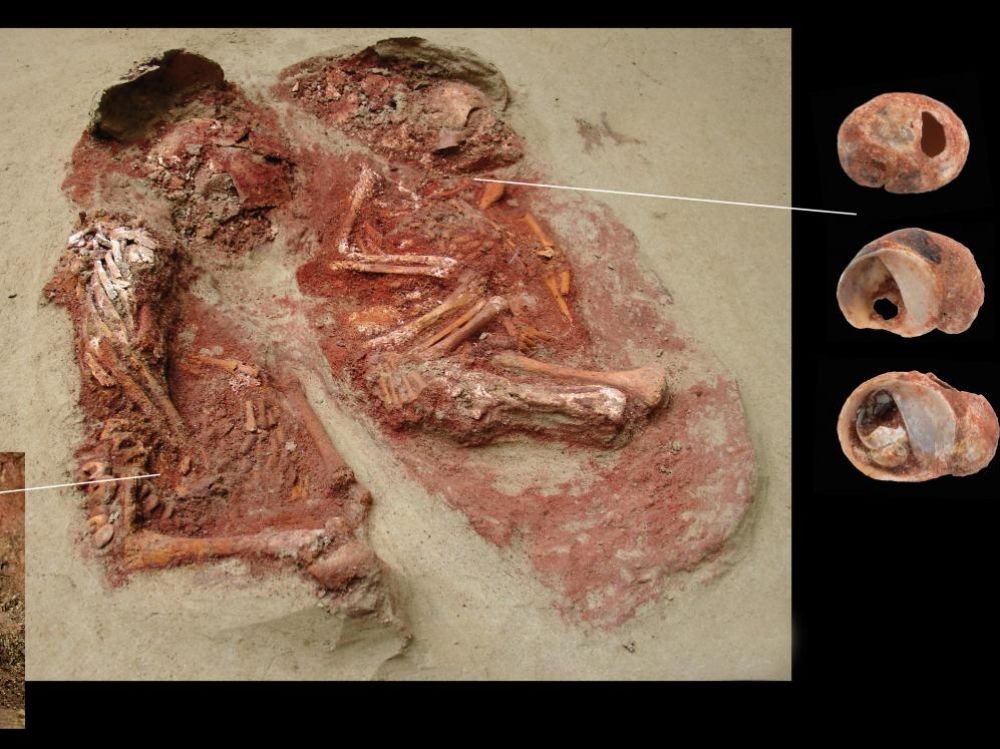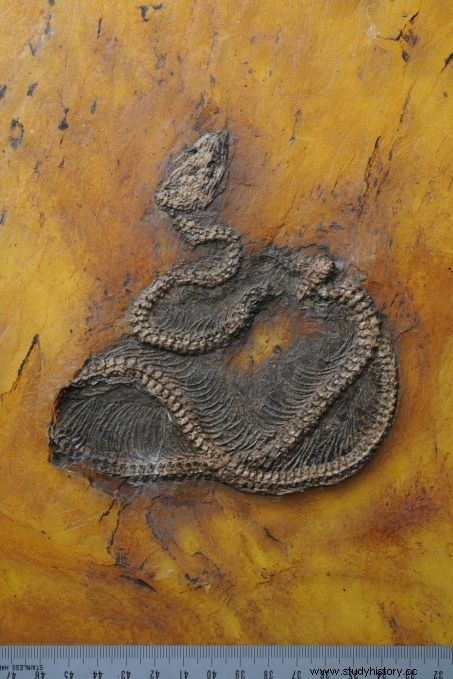The review of the German-speaking press is this time devoted to four archaeological discoveries which reconstruct the past by questioning it. What did twin babies die of more than 30,000 years ago? How did the Jewish community of Cologne live in the Middle Ages? On which continent did pythons appear? What really happened on the Tollense site?

The bodies of two twins in the burial pit, with the offerings placed:mammoth ivory beads, fox incisor and three snail shells.

In 2005, archaeologists discovered on the site of Wachtberg, near Krems (Lower Austria), a burial dating from about 31,000 years in which were two newborns. An interdisciplinary team of researchers has now elucidated the context of this funerary site, unique in the world for several reasons. While this was the world's first discovery of infant skeletons, today we know that the site also provides the first evidence of the birth of twins, since genetic analyzes have succeeded in determining that these infants are monozygotic twins. male. To establish their age, the researchers examined their baby teeth, and more specifically the neonatal line, a dark line that forms in the enamel at the time of birth; they were able to deduce that one of the twins died shortly after delivery, while the other survived around 50 days. The analysis of the presence of barium in the enamel also made it possible to confirm that the first twin was breastfed only very briefly, and the second a little longer.
Another discovery:the two children were not buried at the same time, but successively, as evidenced by the fact that the first is in the middle of the hole dug in the ground, while his brother is buried more at the edge. The tomb was therefore reopened and there was a post-burial, a phenomenon hitherto unknown for the Paleolithic. The elaborate construction of this tomb (the twins were covered in red ochre, then buried under a mammoth shoulder blade), and the jewelry placed as an offering (a necklace with a fox's tooth and three snail shells in pendants for one, a necklace of mammoth ivory beads for the other) attest to the importance of these infants to the group. Scientists see in this double burial "a likely painful episode in the food supply of a group of Paleolithic hunter-gatherers ". This is also evidenced by the presence of a third baby, a cousin no doubt, because he is genetically related to them, found in a second grave near the twins. He lived 13 or 14 weeks, without ever receiving breast milk. .
Pay homage to Kahal Kolonia , the Jewish community of Cologne in the Middle Ages

The city of Cologne, in the Land of North Rhine-Westphalia, is a former Roman colony strategically located on the banks of the Rhine and on the limes of lower Germania (the outer border of the Empire). Its Gothic cathedral is classified as a UNESCO World Heritage Site, and the city would like to obtain this same distinction for two other archaeological complexes that it considers particularly worthy of interest:the Roman part, for which it has already applied, and the remains of the medieval Jewish quarter, the Kahal Kolonia . If the Edict of Emperor Constantine attests that in 321 Jews were already living in Cologne, with rights and duties, we do not know the extent of this community, however, and we do not know if it has could have been maintained continuously until the 10th century, date on which we find traces of it. The excavations carried out under the town hall area to unearth the Roman remains of the Praetorium , the governor's palace, have indeed made it possible to discover that a Jewish quarter dating from the Middle Ages had been built directly on the ruins of ancient buildings. A museum, the MiQua, will allow you to visit the buried buildings:synagogue, hospital, bakery, mikveh (ritual bath)… In the 11th century, between 800 and 1,000 people lived in this enclosed area, but which included exchanges with Christians. The objects and clothing found show that, apart from rituals, daily life in this merchant metropolis was hardly different for the two communities, who lived on good terms for three centuries. Everything changed in 1349, when the Black Death triggered pogroms whose marks the land still bears, traces of destruction, fire, or a precious jewel found in the cesspool, a gold earring that its owner most likely hidden to protect it from looters. In 1424, all the Jews were expelled from the city; the oldest Jewish community north of the Alps goes into exile.
The oldest python ever found lived in Germany

The old quarry of Messel, in Hesse, listed as a UNESCO World Heritage Site, is one of the most important fossiliferous sites in the world. It provides essential information for understanding the first stages of evolution during the Eocene period, 47 million years ago. Many fossils and remains of primates, birds and insects have already been found there. In 2020, however, the discovery of two species of snakes is a turning point for paleontologists, offering the first evidence of their existence. Researchers have just announced that they have found the oldest complete python fossil. About a meter long, the Messelopython freyi is significantly smaller than many current python species, reaching over six meters. Pythons are now only found in Africa, Asia and Australia, but since their origin is unknown, the discovery of this first fossil provides very important evidence for their evolutionary history. The reptile would thus have first evolved in Europe, where the climate was then hot and humid, before being absent from the continent for several million years, because we only find fossils of this family at the time. Miocene (between -23 and -5 million years). Then the cooling of the climate will mark their definitive disappearance from Europe. In January 2020, paleontologists had already reported on the discovery at the Messel site of a first boa specimen, dubbed Eoconstrictor fischeri . They deduce that the first representatives of these two species of large constrictor snakes then cohabited within the same ecosystem, whereas today we consider that they are in competition and cannot share the same habitat. Far from being exhausted, the Messel site will most certainly help to elucidate many more mysteries about the origins of living things.

The new species of python, Messelopython freyi, is the oldest known fossil of a python in the world.
© Senckenberg
Tollense's truth is still buried in the ground

How to interpret the Tollense site? What tools does the archaeologist have to establish the facts? The Spiegel rereads the traces of this unique historical fact, but still incomplete, in the company of several specialists. Far from providing new certainties, recent analyzes have in fact brought to light other suppositions, undermining the theory hitherto put forward by researchers, according to which the first war on the European continent took place 3,300 years ago along of the river Tollense, in the Land of Mecklenburg-Western Pomerania. Since 1996, more than 10,000 pieces of skeletons have been unearthed, indicating an act of violence on an incomparable scale, but is it really a battle between two armies?
The Regional Curator of Archeology of the Land, Detlef Jantzen, today distances himself from this scenario, considering instead the attack of a caravan of merchants by brigands. For him, there is no evidence that the bodies found are those of warriors, because DNA analyzes reveal that some of the victims were women and that the weapons found in the valley cannot be attributed to anyone. Above all, there is no evidence of the presence at that time of an organizational structure that would presuppose the defense of a territory, while the theory of the raid would come to confirm the existence of a long-distance trade on the European continent. .
For archaeologist Joachim Krüger, there is no doubt that there was a confrontation; the number of bodies found scattered represents only a tiny fraction of the potential battlefield and the wounds identified on the bones suggest that the victims came under a hail of arrows. Furthermore, analysis of the strontium content of the bones indicates that some of the victims were from the region, but others were from central or northern Europe; likewise, the arrowheads and numerous fibulae discovered on the site are atypical for the region. It would therefore be possible that native warriors had to defend themselves against a foreign army.
Confrontation between warriors, or aggression of merchants by thieves, the question remains open, and the archaeologists do not despair of finding in the soil of the valley other evidence to support their theses.
